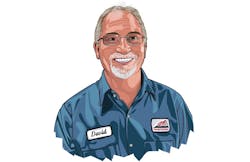David Blackburn never envisioned a career as a service advisor. After all, back in the day, the former drag racer’s personality was as fiery as a hot rod’s exhaust.
Yet, here he is, currently in his 12th year working the front counter at Triangle Car Care in Raleigh, N.C., after more than 30 years working in various roles there, including a long stretch as a technician. Over the years, Blackburn’s old, combustible demeanor has subsided, giving way to a service advisor who is nothing if not personable.
“Twenty years ago, I would not be sitting here,” Blackburn says. “Because I was the typical young man and my fuse was about as short as they come. I was a wrench thrower. ... But over time, coming up here, you learn not every day is going to go smooth, and you just go with it.
“I learned a long time ago, when you pick up that phone, I don’t care how bad the day is and how bad you feel, you want people to think you’re smiling on the other end.”
Nowadays, Blackburn’s communication is exemplary, according to Triangle Car Care owner/manager Bobby Dunn.
“One of the things that technicians usually have trouble with when they switch to the service advisor position is they try to do verbal or ‘driveway’ diagnostics,” Dunn says. “David adjusted very well to letting the technicians do the diagnostics—after he collects symptoms and information from the customer.”
Below, Blackburn details his advice for transitioning from the back of the shop to a service advisor role.
RESPECT YOUR ROLE.
For those transitioning from a position like technician to a service writer job, it’s imperative to largely leave your former role in the past, Blackburn says. When customers call, simply listen, and try not to overstep your current job responsibilities.
“If [customers] ask for your opinion, give it as little as possible. And don’t tell them you were a technician,” Blackburn says. “A service advisor should never, ever say, ‘Well, I was a technician for 30 years.’ I’ve always found that when you do that the customer wants you to sit there and diagnose [repairs] for free.”
ASK QUESTIONS.
One way in which having back-of-the-shop experience can be of benefit to a service advising role is the fact technicians undoubtedly have expansive automotive knowledge. That can be an obvious asset, at times, in the communication process.
“One of the best tips I could tell any service advisor is just ask questions, ask questions, and then ask some more questions,” says Blackburn, who asks probing questions in an effort to find valuable vehicle information to relay to his techs.
Blackburn also frequently touches base with his technicians throughout the day, making certain he has, for example, accurate labor times for each job.
STRIVE FOR POSITIVITY.
Although he may have possessed a tough-guy persona back in the ’70s and ’80s while drag racing in his Chevy Vega, Blackburn has learned that a key requirement of service advising is being a “people person.” Over time, he has embraced that.
“Patience is very, very important in this job,” he says. “It’s tough coming in each day and keeping that smile and attitude, but [customers] are the ones that pay the bills. Without them, you’re nowhere.”
NEVER STOP LEARNING.
Service advising, unlike almost any other role in the industry, requires multitasking.
“You’ve got to put on several hats at one time,” Blackburn says.
Blackburn tries to improve his all-around auto care skills by partaking in training classes taught by industry staples like NAPA or CARQUEST. He also isn’t above trying to learn from so-called competitors, and will occasionally call and speak over the phone with other service advisors in his area.
RESPECT STAFF MORALE.
One harsh lesson most learn when shifting from a tech role to that of a service advisor? You won’t always be popular with coworkers. That’s an inevitability in a position that’s key in doling out assignments.
Yet, it’s critical for a service advisor to occasionally quell simmering unrest among shop workers by being empathetic and supportive.
“A lot of times when things start to boil over in the back, you sort of listen,” Blackburn says. “As a service advisor, I think it’s helpful to every now and then—like once every hour, or every two hours—to get up and walk through the shop. You need to pat them on the back every once in awhile.”



